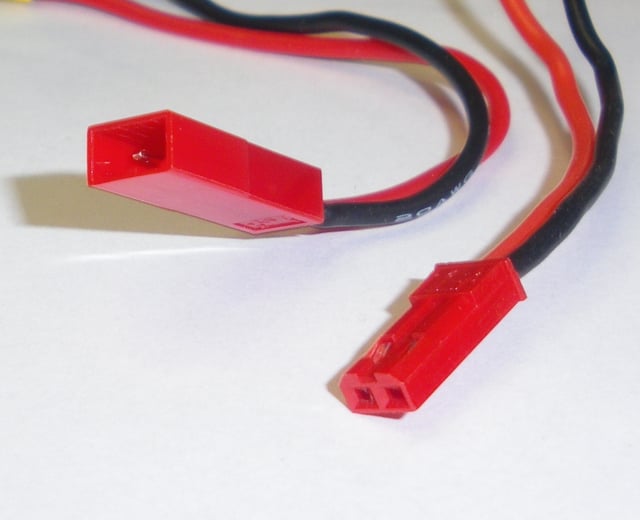DC connector
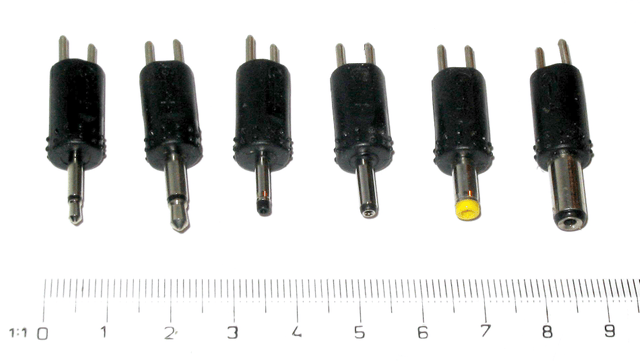
DC connector

A DC connector (or DC plug, for one common type of connector) is an electrical connector for supplying direct current (DC) power.
Compared to domestic AC power plugs and sockets, DC connectors have many more standard types that are not interchangeable. The dimensions and arrangement of DC connectors can be chosen to prevent accidental interconnection of incompatible sources and loads. Types vary from small coaxial connectors used to power portable electronic devices from AC adapters, to connectors used for automotive accessories and for battery packs in portable equipment.
Cylindrical connectors
Small cylindrical connectors come in a variety of sizes. They may be known as "coaxial power connectors", "barrel connectors", "concentric barrel connectors" or "tip connectors".
The intended use of these plugs is on the cable connected to an external AC adapter (power supply). The matching jack or socket is permanently fitted to the equipment to be powered. Some of these jacks contain a normally closed contact, which can be used to disconnect internal batteries whenever the power supply is connected, avoiding the risk of battery leakage or explosion posed by incorrect recharging of the batteries.
Cylindrical plugs usually have an insulated tip constructed to accept insertion of a pin. The outer body of the plug is one contact, most often but not always the negative side of the supply. Inverted polarity plugs can, and do, damage circuitry when plugged in, even if the voltage is correct; not all equipment is equipped with protection. A pin mounted in the socket makes contact with a second internal contact. The outer plug contact is often called the barrel, sleeve or ring, while the inner one is called the tip.
There are a wide variety of sizes and designs for these power connectors, and many appear quite similar to each other yet are not quite mechanically or electrically compatible. In addition to a plethora of generic designs (whose original designer is unknown) there are at least two different national standards—EIAJ in Japan and DIN in Germany, plus the JSBP connector used on some laptop computers. The Japanese EIAJ standard includes five different sizes, with each supporting a specified range of voltages. Most of the other coaxial DC power connectors have no specified voltage association, however. Generic plugs are often named for the pin diameter they are designed to take.
Many non-proprietary co-axial power plugs are 5.5 mm (0.22 in) in outside diameter (OD) and 9.5 mm (0.37 in) in length. Two pin sizes are common in the jacks for this size plug body, 2.1 mm (0.083 in) and 2.5 mm (0.098 in), and the plugs should match. If the size is not known, it is difficult to distinguish by eye or measurement between the 2.1mm and 2.5mm ID plugs; some suppliers suggest simple methods.[1]
Maximum current ratings commonly vary from unspecified up to 5 A (11 A for special high power versions from some companies[2]), with 1 A, 2 A and 5 A being common values.[3] The smaller types usually have lower ratings, both for current and voltage. The 'tip' (i.e., the inner conductor) usually carries the positive (+) pole, but some devices, and their power supplies, use negative tip. Connector size does not usually indicate the voltage. It is not possible, except for some proprietary connectors, to reliably infer any information on power parameters (current, voltage, polarity, even whether AC or DC) by examining the connector.
Snap and lock DC power connectors
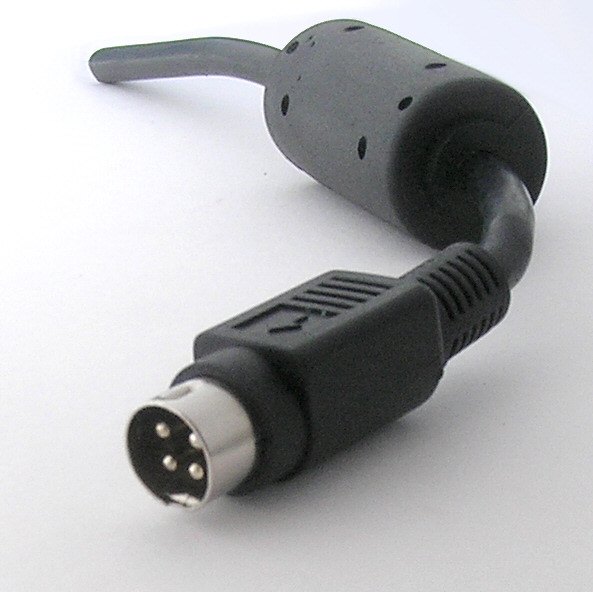
A male 4-pin "Kycon" power connector, which appears similar to a Mini-DIN connector
Snap and lock DC power connectors look similar to Mini-DIN connectors, but have either 3 or 4 thicker pins and a slightly larger mating shell. Because of this they do not mate with any of the standardized Mini-DIN connectors. Some devices, however, use a true 4-pin Mini-DIN connector for power instead, presenting the possibility to mate such a connector with the wrong port (such as an S-Video output).
Known as Kycon 3-pin and 4-pin DC power plugs.
Erroneously also known as "Power DIN",[4] although different from any standardized Mini-DIN or DIN connector type.
The male plug's mating shell outer diameter is 10 mm (0.39 in), and the pins are 1.5 mm (0.059 in) diameter
Standard may include a limit of 20 V at 7.5 amperes[5]
Sometimes, there's a knurled retaining ring surrounding the male plug which allows fastening the plug to the chassis receiving the power.
Molex connector
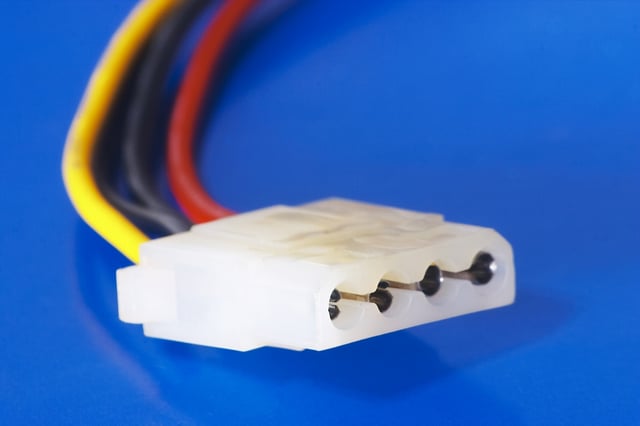
A Molex connector
Molex connectors were frequently used as DC power connectors in personal computers, for floppy, hard disk, and CD drives. These connectors have four pins, +5 V (red), 2 common ground (black), and +12 V (yellow). SATA peripherals use a different style of connector.
Locking Molex connectors are available in 3, 4, and 6 terminal configurations.
IEC 60906-3:1994
The International Electrotechnical Commission (IEC) has produced a standard for a system of 2-pin plugs and socket-outlets for household and similar purposes in fixed and portable applications, either indoors or outdoors. Safety extra-low voltage (SELV) plugs and socket-outlets carry up to 16 amperes, and have eight keying possibilities, to indicate 6, 12, 24, or 48 volts, AC or DC.
The connector is circular, with the male connector having two pins placed symmetrically inside a circular shield, and the female connector having two receptacles surrounded by a circular groove to accept the male shield, in turn surrounded by a second circular shield which projects 6 mm (0.24 in) past the mating surface and encloses the male connector.
The dimensions are as follows:[6]
| Parameter | Value |
|---|---|
| Pin-to-pin distance | 7.0 ± 0.1 mm (0.276 ± 0.004 in) |
| Pin diameter | 3.5+0.000 −0.075 mm(0.140+0.000 −0.003 in) |
| Pin length | 9.5 mm (0.374 in) (ref) |
| Female pin receptacle | 4.0 ± 0.1 mm (0.157 ± 0.004 in) |
| Female body diameter | 15.6 ± 0.15 mm (0.614 ± 0.006 in) |
| Female groove depth | 10.0 ± 0.2 mm (0.394 ± 0.008 in) |
| Male shield inner diameter | 16.0+0.2 −0.1 mm(0.630+0.008 −0.004 in) |
| Male shield length | 10.0+0.5 −0.0 mm(0.394+0.020 −0.000 in) |
| Male pin tip to shield tip | 0.5 ± 0.2 mm (0.020 ± 0.008 in) |
| Male shield outer diameter | 19.0 ± 0.1 mm (0.748 ± 0.004 in) |
| Female shield inner diameter | 19.4 ± 0.2 mm (0.764 ± 0.008 in) |
| Female shield length | 16.0 ± 0.2 mm (0.630 ± 0.008 in) |
The male shield has two keys projecting inwards, which fit into notches in the female body. The larger key is at right angles to the pins, 2.0 ± 0.1 mm (0.079 ± 0.004 in) wide and ending at a radius of 4.9 ± 0.1 mm (0.193 ± 0.004 in) from the connector centre. The corresponding notch is 2.3 ± 0.1 mm (0.091 ± 0.004 in) wide and ends at a radius of 4.6 ± 0.1 mm (0.181 ± 0.004 in) from the connector centre.
The angle of the second key from the first indicates the voltage and current type. The 8 permitted angles are multiples of 30° which are not multiples of 90°. Angles of ±30° and ±60° indicate alternating current (50 or 60 Hz), while angles of ±120° or ±150° indicate direct current with the pin at 90° being negative and the pin at 270° being positive.
The second key is smaller than the first, 1.5 ± 0.1 mm (0.059 ± 0.004 in) wide ending at a radius of 6.4 ± 0.1 mm (0.252 ± 0.004 in) from the connector centre. The corresponding notch in the female connector body is 1.8 ± 0.1 mm (0.071 ± 0.004 in) wide and ends at a radius of 6.2 ± 0.1 mm (0.244 ± 0.004 in) from the connector centre.
With the angles measured clockwise looking at the female connector (counter-clockwise looking at the male), the various key positions indicate:
| Angle | Supply |
|---|---|
| 30° | 6 V AC |
| 60° | 12 V AC |
| 120° | 6 V DC |
| 150° | 12 V DC |
| 210° | 24 V DC |
| 240° | 48 V DC |
| 300° | 24 V AC |
| 330° | 48 V AC |
The so-called "Mini IEC connectors" are unrelated and not even standardized by the IEC at all; they are called that because they resemble a smaller IEC C13 connector.
Outdoor light systems connectors
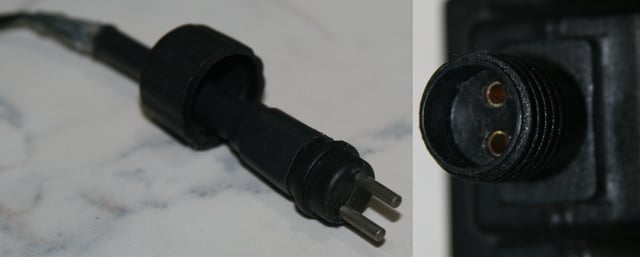
Outdoor light system connectors

Outdoor light system connector dimensions
Mainly used on outdoor Christmas lights, this a common IP44 connector for light systems. The most common voltage is 24 V, but 12 and 48 V may use the same socket and plug. The male has two pins and a threaded ring, which once screwed to the female ensures water resistance and mechanical retention.
Tamiya connectors
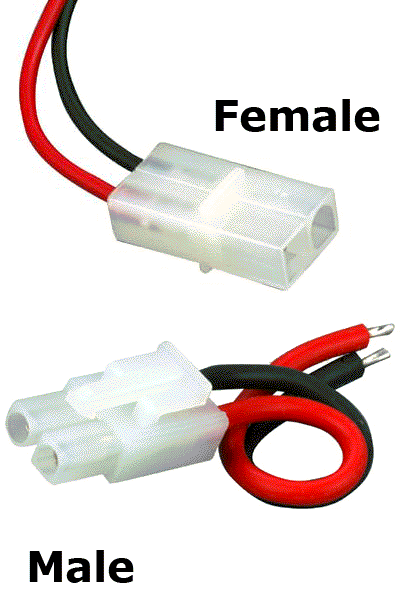
A Tamiya Connector
Tamiya connectors are commonly used on radio-control (toy) vehicle battery packs and chargers.
JST RCY connector
Inverter tabs/lugs
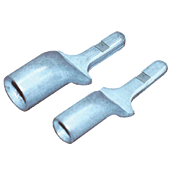
Inverter lugs
Inverter tabs/lugs are available in 2, 4, and 8 AWG. These are designed to pass very high currents at voltages up to 600 V DC to and from battery packs, inverters, and other high-current loads to a terminal bus.
Airline in-seat power supply system
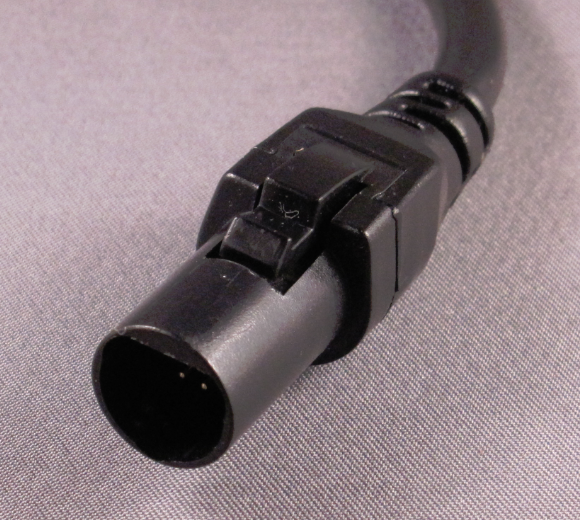
An Empower Plug
Two different airline in-seat power supply system (ISPSS) standards for DC power have been used in the past. American Airlines in the past used an automotive cigar lighter socket. Most other airlines that provide DC power use the smaller EmPower system, which has a 4-pin Hypertronics' D-series connector. It can supply 15 volts maximum 5 amperes.
Anderson Powerpole connectors
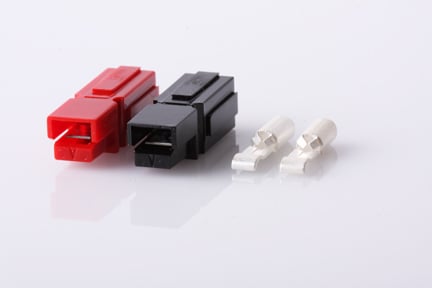
An Anderson Powerpole
Powerpole connectors are physically and electrically hermaphroditic, thus avoiding the need to worry about which end is the plug and which the socket, or which end has the correct polarity, as is the case with the physically but not electrically hermaphroditic 2-wire trailer plug.
Powerpoles have been adopted as a standard 12 VDC connector by most RACES Radio Amateur Civil Emergency Service organizations and ARES Amateur Radio Emergency Service units. They deliver good current capability for their sizes. They also facilitate very easy pluggability for those with good eyesight or good lighting; somewhat difficult otherwise. However they are also easily damaged and tend to separate from each other easily with very little force.
SAE connector
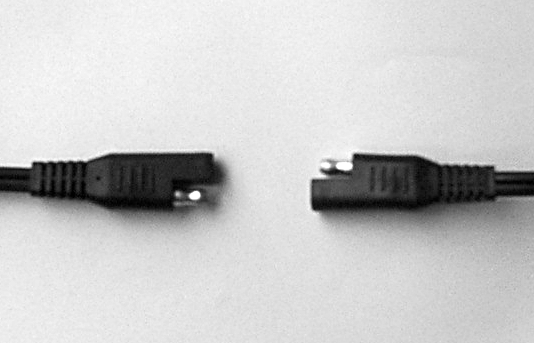
An SAE connector
The SAE connector is a hermaphrodite two-conductor DC connector commonly used for solar and automotive applications (also motorcycles). It is so named for the Society of Automotive Engineers who created its specifications.
This connector is typically used for applying a maintenance charge to a vehicle battery. The polarity of the connector, when installed in a vehicle and attached to a battery, is always such that no short circuit will occur if the exposed terminal were to touch the vehicle chassis. In most vehicles, this means that the exposed terminal connects to the negative terminal of the battery. Conversely, the positive terminal on a battery charger is exposed, to mate with the concealed one on the vehicle side. (On vehicles with a positive-ground frame, such as vintage British motorcycles, this is reversed.)
Although there is a risk of short-circuiting a battery charger, the risk is minimal and often mitigated by the circuitry of the battery charger itself. On the other hand, the short circuit current of the lead-acid batteries installed in vehicles is sufficiently great, that a short circuit could result in a fire or explosion. The priority is therefore given to avoiding short circuits of the vehicle battery, rather than of the charger.
Car lighter sockets and plugs
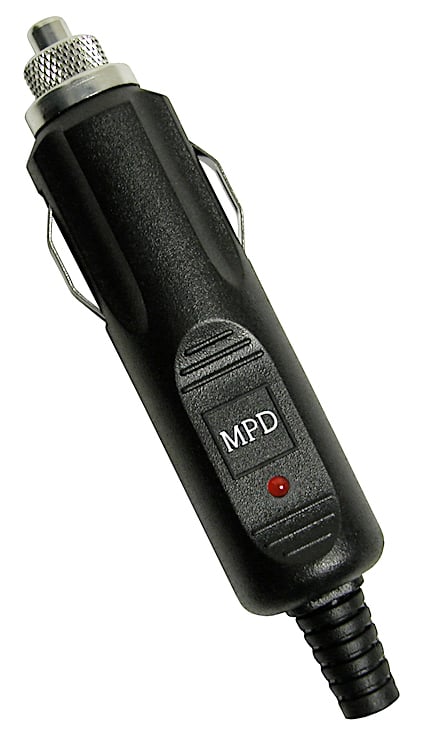
A 12 Volt cigar lighter plug
The car power outlet is also called a cigarette lighter receptacle, or cigar lighter receptacle, since it was originally designed as a lighter for cigars—hence its rather large size. Nowadays, it is used to power automotive accessories such as portable inverters, mobile phone chargers and portable fridges.
These sockets were not originally designed to provide DC power, and are not an ideal DC connector for several reasons, but still widely used for compatibility to existing accessories. Three sizes exist, one for 6 VDC and two for 12 VDC and the mating of the different sized 12 VDC plugs and jacks is problematic. Because of this, and the small gauge wire sometimes used, they may provide unreliable power connections.
The polarity for 12 VDC sockets is center pin positive (+), outer collar negative (−). Reversed polarity will damage some electronic devices.
Although the nominal voltage of a 12 V lead acid battery is 12 VDC, when the engine is running the car's battery charging system will bring the system voltage to 13.8 VDC or higher.[9] The possible range of battery voltages from 11–15 VDC must be taken into account by devices attached to the cigar lighter socket.
This connector is also often used for powering accessories on motorcycles, such as heated clothing (vests, gloves, etc.) or GPS units. This makes "plugging in" easier to manage while wearing gloves. As the accessory lacks any power of its own, there's no risk of "shorting" the exposed connector.
ISO 4165 connector
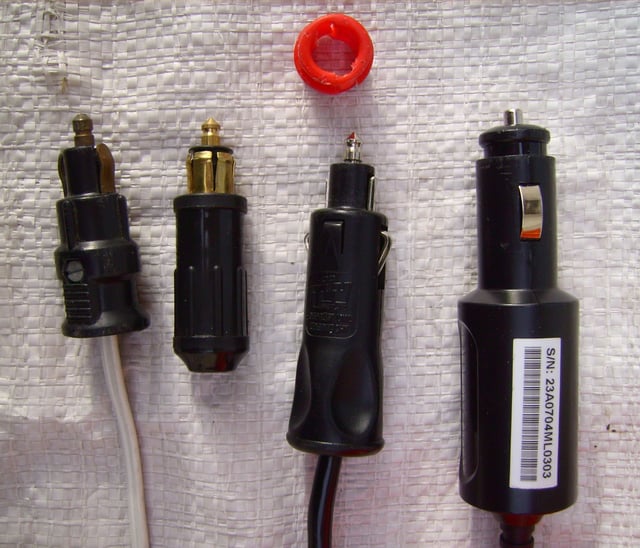
ISO 4165
Similar in concept to an automotive cigar lighter, the ISO 4165 connector is shorter and smaller.
Found most frequently on motorcycles, it is also known as a "BMW Accessory", "Hella", "Merit", "Norm" or "Powerlet" connector.
XLR connectors used for power
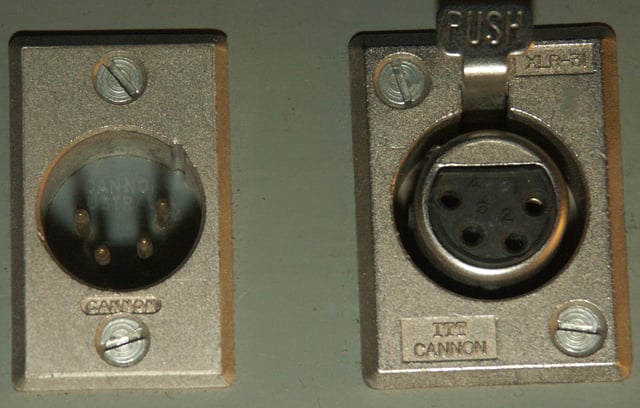
XLR4
In the broadcast, film and television industries, the 4-pin XLR connector is the standard for 12 V power. The connectors are wired pin 1 negative, pin 4 positive. Often pins 1 and 2 will be negative, 3 and 4 positive for a higher current rating. Female connectors are used as supply and male connectors are used on loads. Most battery belts and power supplies output 13.2 V, but equipment can usually handle a range of 11–18 volts to accommodate battery packs of varying voltages and charging while operating.
The readily available XLR3 is also used by some manufacturers as power supply plugs despite their being a well-accepted standard for other purposes.
Clipsal connectors
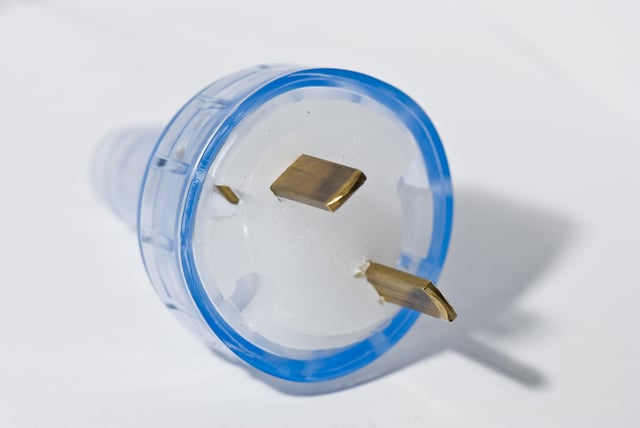
Clipsal 492/32 DC plug, not wired
In Australia, a T-configuration Clipsal socket is used for extra-low voltage DC power outlets, such as in stand-alone power systems (SAPS) or on boats, in order to prevent accidental connections of 12 V appliances into 240 V socket-outlets.[10] This connector is also used for temporary equipment in emergency vehicles.
The connector pins are mutually perpendicular, and are usually oriented to look like a capital T. In the state of Victoria, the top of the T is taken to look like a minus sign, and has been assigned to negative polarity. In the rest of Australia, the vertical pin is assigned to earth/chassis ground, consistent with Australian Standards for Type I 240 volt outlets; therefore, the top of the T is positive on a negative-earth vehicle. Older positive-earth vehicles are still in service, so actual polarity at the outlet can be random, and must be verified to avoid equipment damage.
USB socket
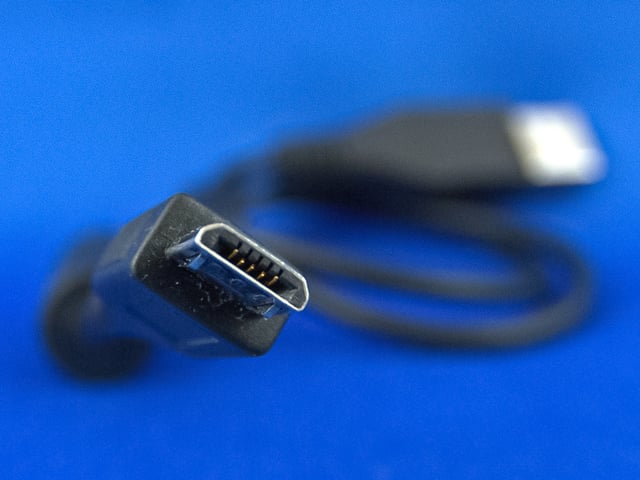
Micro-B USB
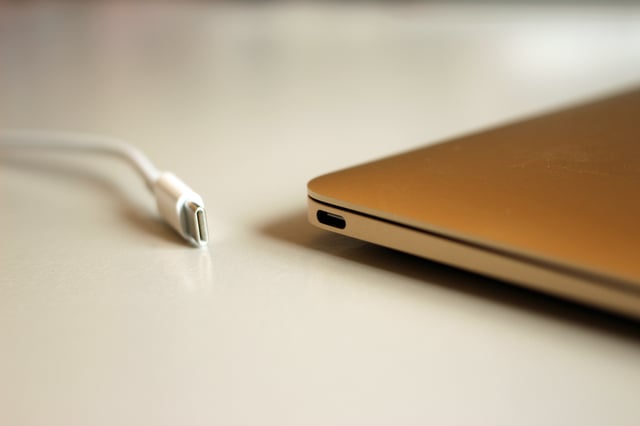
The 12-inch 2015 MacBook uses a USB-C port for charging
Due to the popularity of USB for mobile phones and tablets, USB sockets and plugs have become a common choice for other small devices that require five volts or less, even those that require no data connection. Examples include flashlights, toys such as small helicopters, and rechargeable battery packs (which in turn provide five volts over USB to recharge other devices). Wall sockets with built-in USB power adapters and USB sockets are available.
The EU has adapted the common external power supply specification, which standardizes data-enabled mobile phones to use the micro USB-B connector. As of 2016, most new mobile phones use this connector for charging.
In 2012, the USB Power Delivery (PD) specification was released. The USB PD specification provides the ability for 5 V devices to draw more than (the USB battery-charging specification limit of) 7.5 W of power from USB "PD-aware" ports when using PD-aware USB cables. The specification also allows USB PD ports to provide even greater power at higher voltages over PD-aware cables – up to 36 W at 12 V and 60 W at 20 V (for micro-USB connectors) and up to 60 W at 12 V and 100 W at 20 V (for standard USB A/B connectors).[11]
The new USB-C plug is expected to eventually become the new standard for charging (and data transfer) over USB.[12]
MC4 Connector
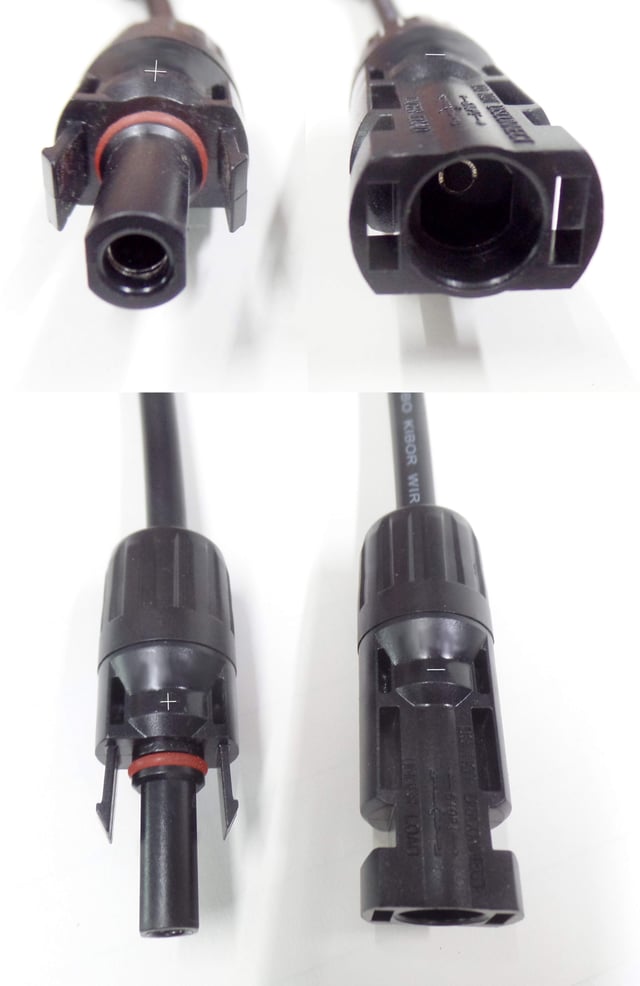
MC4 connectors, used on solar panels.
MC4 connectors are common on photovoltaic panels. Because these panels are exposed to the weather for decades, MC4 includes a rubber sealing ring to keep out moisture. Because solar panels are often stacked in strings of hundreds of volts, MC4 has locking clips to hold the wires together. Because solar panels can be connected in series strings, or parallel arrays, the positive and negative terminals use separate connectors.
Other DC connectors
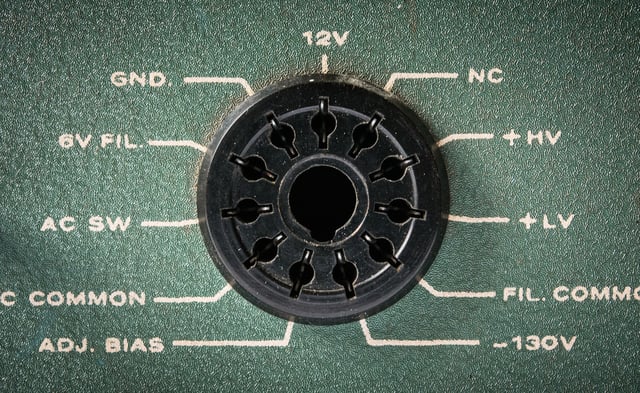
Heathkit power supply female connector for tube equipment
There are a number of similar design PC board power connectors, including Molex Mini-Fit SR, Molex Mini-fit jr., MOLEX MICROFIT and Molex SABRE connectors, and AMP DUAC connectors that look similar to each other.
Some plugs with three, four, five or more pins are also called DC plugs. These were common on vacuum tube equipment and continue to be used where several voltages are supplied. On vacuum tube equipment the pins are normally on the equipment side of the join for safety reasons.
Many mobile phones use DC connectors that are unique to the manufacturer, or even a specific phone. In the interest of improved interoperability of phone battery chargers, major manufacturers have agreed to standardize on the micro-USB connector for new phone chargers from 2010.[13]
Many manufacturers make special-purpose DC power connectors for battery packs, instruments, medical equipment, communications equipment and other devices.
Power Pack (PP) series of batteries such as the PP3 nine-volt battery have circular and hexagonal terminals which mate with a "snap" connector with physically identical (but opposite-polarity) terminals.
Special "octal" connectors with either 8 or 11 pins, almost identical to octal relay sockets or tube sockets, were used to connect power supplies to some tube audio amplifiers, transmitters, and transceivers (especially in amateur radio models). Female sockets were installed on the power supply and male sockets (with exposed pins) on the radio equipment. Cable assemblies with mating connectors were also readily available. These connections transferred anode positive voltage (typically 600 VDC for Heathkit, 800 VDC for Collins), grid negative bias (-130 VDC), 6.3 and 12.6 VAC for heaters (filaments), and control functions (remote mains switching).
See also
Banana connector
Battery terminal
Binding post
Blade connector
MagSafe
MC4 connector
Phone connector (audio)
RCA connector
Speaker terminal
Telephone plug
Universal Serial Bus
